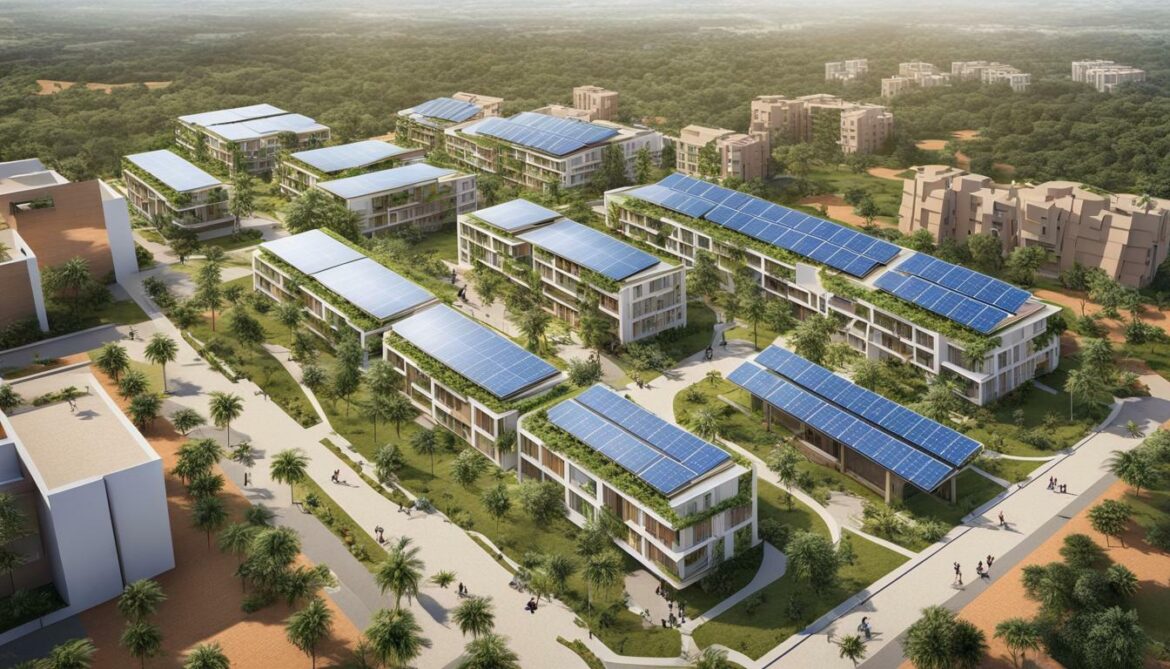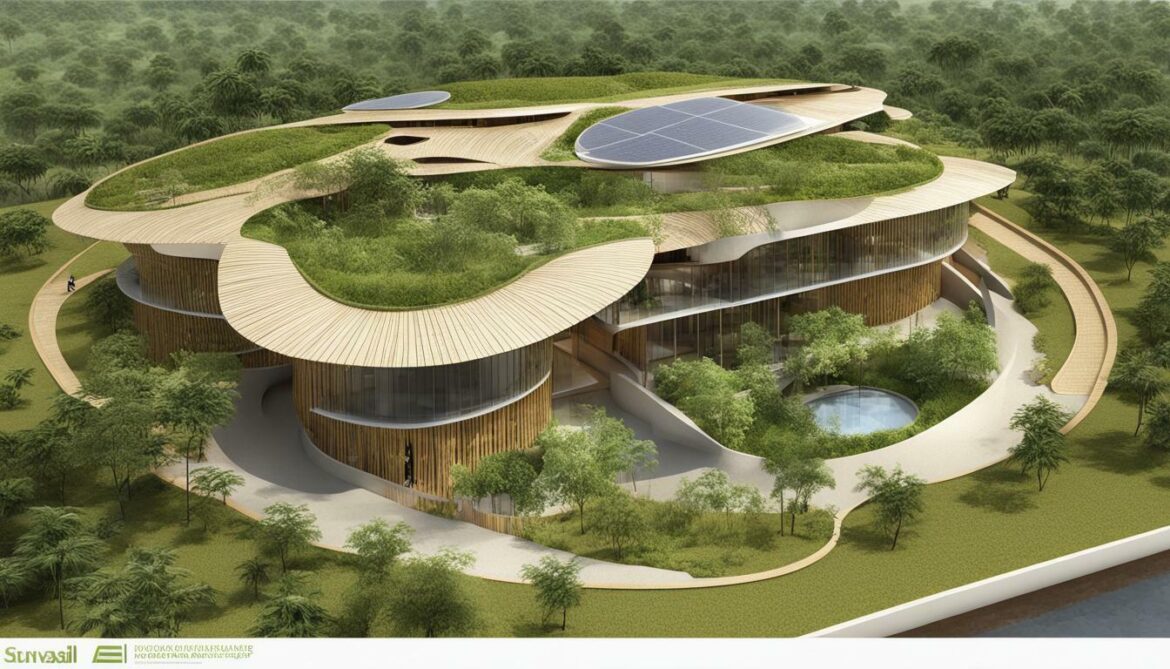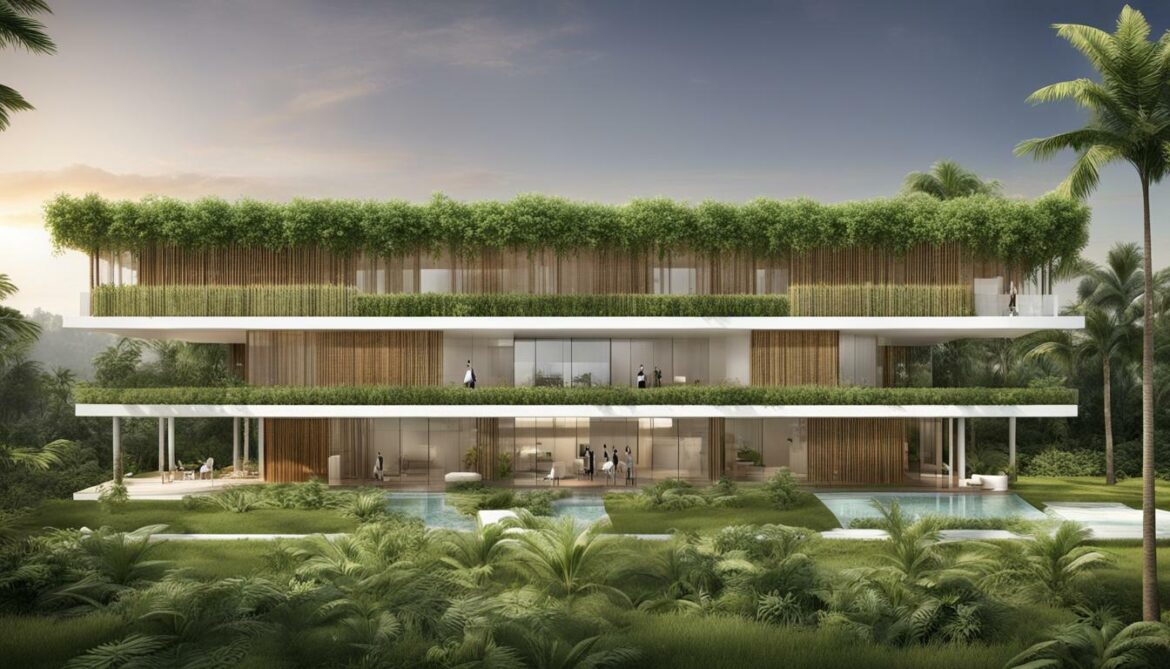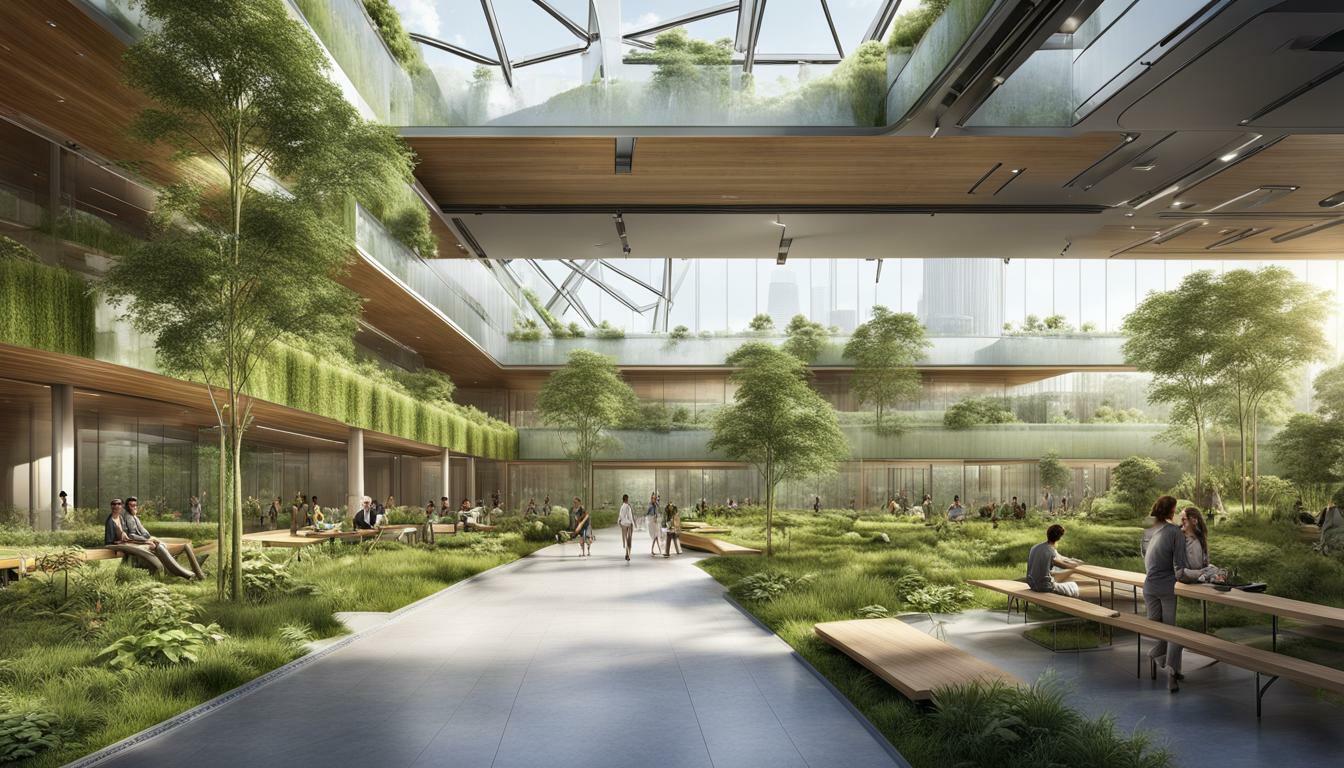Green building practices have become increasingly important in Angola as the country strives to build a sustainable future. Sustainable construction and eco-friendly architecture have gained popularity in recent years, driven by the need to reduce environmental impact and promote energy efficiency.
Angola is committed to implementing green building practices and has made significant progress towards this goal. The use of environmentally-friendly materials and design techniques, innovative green technologies, and energy-efficient buildings have become the norm in the country’s construction industry. Let’s explore the Green Building Practices in Angola.
Key Takeaways:
- The concept of green building and sustainable construction is important in Angola.
- Eco-friendly architecture has gained popularity in recent years.
- The use of environmentally-friendly materials, innovative green technologies, and energy-efficient buildings have become the norm in Angola’s construction industry.
- The country’s history makes it an interesting case study, when it comes to low cost sustainable green building practices in Angola
Advancements in Sustainable Construction
Angola has made significant strides in sustainable construction practices, implementing eco-friendly innovations to reduce environmental impact. The country is committed to green building practices, with a growing emphasis on the use of sustainable materials and green technologies to create energy-efficient buildings.
One notable advancement is the use of green roofs, which are becoming increasingly popular in Angola. These roofs are covered with vegetation, providing insulation for buildings and reducing the heat island effect in urban areas. The plants also absorb carbon dioxide, improve air quality, and reduce stormwater runoff.
Another innovative technology is the use of solar panels for renewable energy in buildings. By harnessing the power of the sun, solar panels provide a clean and sustainable energy source, reducing reliance on non-renewable resources. In addition, the use of LED lighting and energy-efficient appliances further minimizes energy consumption and reduces costs.
| Green Technologies |
Description |
| Green roofs |
Vegetated roofs that provide insulation, absorb CO2, and reduce stormwater runoff. |
| Solar panels |
Renewable energy source that harnesses solar power for buildings. |
| LED lighting |
Low-energy lighting technology that reduces electricity consumption. |
The use of sustainable materials is also becoming increasingly popular in Angola’s green building industry. Architects are employing recycled materials and sustainable alternatives to traditional building materials, such as bamboo, which is fast-growing, renewable, and durable. In addition, building designs are incorporating passive solar heating and cooling techniques to reduce energy use.
The integration of green technologies in sustainable construction practices not only reduces environmental impact but also creates healthier and more comfortable living and working spaces. The inherent benefits of green buildings, such as improved air quality and enhanced thermal comfort, promote human wellbeing and productivity, making them a valuable investment for the future.

In the next section, we will showcase some of Angola’s signature eco-friendly structures and the sustainable design features that contribute to the country’s green building movement.
Signature Eco-Friendly Structures
Angola is home to several impressive eco-friendly structures, showcasing sustainable design features and environmentally conscious construction methods. These signature buildings serve as beacons of inspiration for future sustainable development efforts in the country.
Luanda Convention Center
The Luanda Convention Center is an iconic structure and a prime example of innovative eco-friendly architecture in Angola. The building incorporates sustainable design features such as solar panels, energy-efficient lighting, and rainwater harvesting systems, reducing its impact on the environment. The convention center’s modern design also includes green spaces, promoting the use of natural ventilation and providing a pleasant environment for visitors.

Kilamba City
Kilamba City, a planned urban development in Angola’s capital city, is another landmark project that utilizes sustainable design and construction practices. The city features energy-efficient buildings, green spaces, and pedestrian-friendly streets, creating a sustainable and liveable community for its residents. Kilamba City’s approach sets a new standard for urban development in Angola and serves as a model for future sustainable cities in the region.
Palanca Peace Pavilion
The Palanca Peace Pavilion is an award-winning structure that showcases innovative sustainable design features. The building boasts a unique shape that enhances natural ventilation while reducing energy consumption. The pavilion also incorporates greenery into its design, providing a lush environment for visitors while promoting biodiversity. Its eco-friendly features have earned it international recognition as a stellar example of sustainable architecture.
These signature eco-friendly structures are just a few examples of Angola’s commitment to sustainable construction and eco-friendly architecture. By showcasing innovative design techniques and sustainable construction materials, these buildings demonstrate that it is possible to build structures that have a positive impact on the environment and support a sustainable future.
Sustainable Materials and Design
Green building practices in Angola prioritize the use of sustainable materials and design techniques to reduce environmental impact and improve sustainability. From the use of recycled materials to the incorporation of renewable energy sources, sustainable design and construction play a significant role in the country’s green building movement.
Various sustainable materials are being employed in Angola’s green building industry. For instance, bamboo is increasingly being used as a building material due to its renewability, low cost, and durability. Additionally, eco-friendly insulating materials like sheep’s wool and cellulose are being used to reduce energy consumption and minimize the release of greenhouse gases into the atmosphere.
The use of sustainable design techniques also contributes to the overall sustainability of construction projects in Angola. Passive solar design techniques, for example, maximize natural lighting and heat from the sun, reducing the need for artificial lighting and heating. Building orientation, placement of windows, and materials used in construction are all factors considered in sustainable design.
Furthermore, the use of green building materials in construction projects can also improve indoor air quality. For instance, low-VOC paints and adhesives, which contain fewer harmful chemicals, can significantly reduce indoor air pollution and improve the overall environmental quality of a building.
Investing in sustainable materials and design not only helps to protect the environment but also saves costs in the long run. By minimizing energy consumption and reducing the need for artificial lighting and heating, sustainable building practices can lead to significant cost savings on energy bills for building owners.

Incorporating sustainable materials and design is an essential part of green building practices in Angola. By prioritizing sustainability, the country is taking a step towards a greener future.
Energy Efficiency in Buildings
In Angola, the use of energy-efficient buildings is a critical aspect of sustainable construction and green building practices. With concerns about climate change and the need to reduce carbon emissions, buildings that maximize energy efficiency are becoming the norm.
One of the strategies employed to achieve energy efficiency is the use of passive design techniques. This approach involves designing buildings to use natural sunlight and ventilation to reduce the need for artificial lighting and air conditioning. By taking advantage of the natural elements, buildings can minimize energy usage while creating a comfortable and healthy living environment for occupants.

In addition to passive design, the use of energy-efficient technologies and systems is another crucial aspect of green building practices. These include heating and cooling systems, lighting systems, and appliances that have high energy efficiency ratings. The integration of renewable energy sources such as solar panels and wind turbines is also becoming increasingly popular in Angola.
By employing these energy-efficient strategies and technologies, buildings in Angola can reduce their overall energy usage and carbon footprint while still providing a high level of comfort and functionality for occupants. The long-term benefits of energy efficiency in green building practices are significant, both for the environment and for building owners in terms of reduced energy costs.
Environmental Impact and Benefits
Green building practices in Angola have a positive impact on the environment and contribute to a sustainable future. The use of environmentally-friendly construction methods promotes energy efficiency, reduces carbon footprint and conserves natural resources. By using sustainable design and green building materials, construction projects in Angola can significantly reduce waste and contribute to a greener planet.
One of the key benefits of green building practices is the improved air and water quality in buildings. By using sustainable materials and design, indoor air quality is improved, reducing the risk of respiratory problems and other health issues. Additionally, the use of water-saving technologies and systems reduces water consumption and helps promote water conservation.
Another benefit of green building practices is their positive impact on the local economy. Green buildings in Angola create jobs in the construction industry and increase demand for sustainable products and services. This, in turn, promotes local entrepreneurship and helps boost the economy.
The adoption of green building practices also helps businesses in Angola save money in the long term. Energy-efficient buildings reduce energy consumption and lower operational costs. This allows companies to allocate resources to other business needs and helps improve profitability.

Overall, environmentally-friendly construction in Angola plays a significant role in promoting sustainable development. By reducing the carbon footprint, conserving natural resources, and improving air and water quality, green building benefits the environment and the economy. As the green building movement grows in Angola, we can look forward to a future of environmentally-responsible construction and a greener planet.
Government Initiatives and Policies
Green building practices in Angola are strongly encouraged and supported by the government. The country has adopted a number of initiatives and policies aimed at promoting sustainable construction and eco-friendly architecture.
One of the key policies in place is the National Strategy for Sustainable Development (ENDS) which emphasizes the need for sustainable infrastructure and buildings. The ENDS aims to reduce the country’s environmental footprint and promote economic growth through sustainable development.
The Angolan government has also established the National Institute for Building Standards (INN), which is responsible for regulating and promoting sustainable construction practices. The INN works closely with industry professionals and experts to develop and implement standards for green building projects.
In addition to these policies, the government also offers incentives to developers and builders who prioritize sustainable construction practices. This includes tax breaks for energy-efficient buildings and grants for projects that incorporate sustainable design and materials.
Overall, these government initiatives and policies have played a crucial role in promoting green building practices and sustainable construction in Angola. By encouraging environmentally-friendly practices and offering incentives for sustainable design, the government is paving the way for a more sustainable future.

Conclusion
In conclusion, green building practices have become increasingly important in Angola as the country strives to reduce its carbon footprint and promote sustainable construction. The advancements in sustainable construction practices and the use of innovative green technologies have allowed for the creation of energy-efficient buildings and reduced environmental impact.
Angola’s signature eco-friendly structures demonstrate the effective use of sustainable materials and design techniques, which enhance the overall sustainability of construction projects. Energy efficiency in buildings is also vital, and Angola has employed various strategies and technologies to maximize energy efficiency and reduce carbon footprint.
The positive environmental impact of green building practices in Angola is significant, with benefits ranging from reduced greenhouse gas emissions to improved indoor air quality. The government has been instrumental in promoting and supporting green building practices through the implementation of regulations and incentives to encourage sustainable construction and eco-friendly architecture.
In summary, it is clear that green building practices are essential to a sustainable future in Angola and beyond. Continued innovation in sustainable construction and a commitment to environmentally-friendly construction methods will further contribute to a greener future.
FAQ
Q: What is green building?
A: Green building refers to the practice of creating environmentally-friendly and sustainable structures using resource-efficient techniques and materials.
Q: Why is green building important in Angola?
A: Green building is important in Angola because it helps to reduce the country’s carbon footprint, preserve natural resources, and create healthier and more sustainable living environments.
Q: What are the benefits of eco-friendly architecture?
A: Eco-friendly architecture offers numerous benefits, including reduced energy consumption, improved indoor air quality, and lower maintenance costs.
Q: How are sustainable materials used in green building?
A: Sustainable materials, such as recycled or renewable resources, are used in green building to reduce waste, conserve energy, and promote a more sustainable construction industry.
Q: What are some green technologies used in sustainable construction?
A: Green technologies used in sustainable construction include solar panels, rainwater harvesting systems, and energy-efficient HVAC systems, among others.
Q: How does energy efficiency contribute to green building?
A: Energy efficiency plays a crucial role in green building by reducing energy consumption and carbon emissions, resulting in cost savings and a more sustainable built environment.
Q: What government initiatives support green building practices in Angola?
A: The Angolan government has implemented various initiatives and policies, including regulations and incentives, to promote and support green building practices across the country.
You may also like Green Building in Antigua and Barbuda
























Post comments (0)